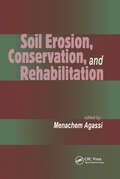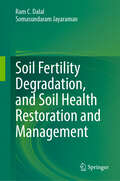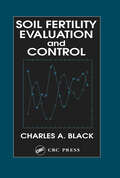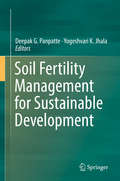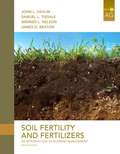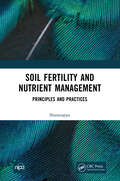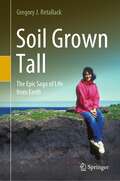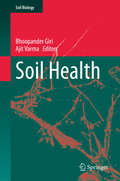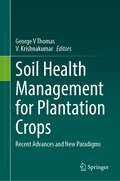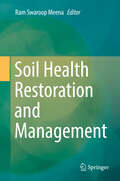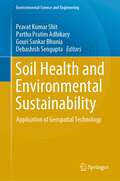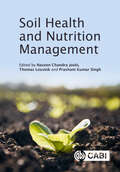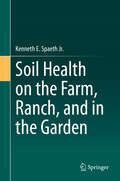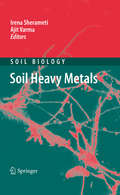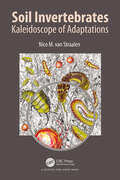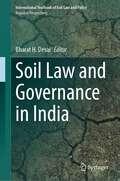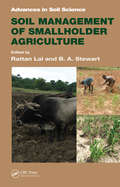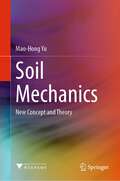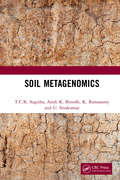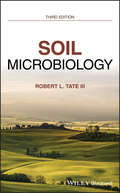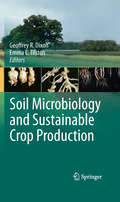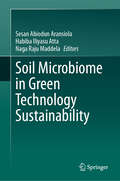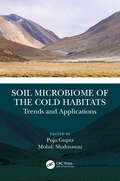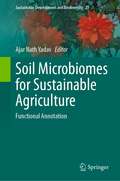- Table View
- List View
Soil Erosion, Conservation, and Rehabilitation
by Agassi,Discusses the latest information regarding the processes and mechanisms responsible for runoff and erosion by water in arable lands--detailing state-of-the-art water and soil conservation methods. Elucidates the rehabilitation of agricultural lands depleted by human activity.
Soil Fertility Degradation, and Soil Health Restoration and Management
by Ram C. Dalal Somasundaram JayaramanThis monograph provides a comprehensive collection of information on soil fertility degradation across various climatic zones and soil orders. It focuses on physical, chemical, and biological degradation of soil, offering insights into sustainable soil management practices for restoring degraded soils. The book details the processes and causes of soil degradation, including structural degradation, erosion, nutrient depletion, nutrient mining, decline of soil organic matter, and biological degradation, while highlighting strategies to mitigate and remediate these issues in different climatic zones. Unsustainable farming practices have accelerated soil degradation globally, leading to soil erosion, nutrient loss, and structural damage. Nutrient depletion and the loss of soil organic carbon are among the most critical concerns, but these trends can be reversed with sustainable management practices and appropriate technologies. This book addresses the challenges of fertility-degraded soils and offers wide range of management and restoration strategies to ensure food and nutritional security, maintain ecosystem services, and attain Sustainable Development Goals under various agro-climatic conditions worldwide. This book is a valuable reference material for researchers, scientists, students, farmers, and land managers seeking efficient and sustainable natural resource management. It also serves as essential reading material for undergraduate and postgraduate students in agriculture, soil science, agronomy, agrophysics, agrobiology, and environmental and climate sciences.
Soil Fertility Evaluation and Control
by Charles A. BlackSoil Fertility Evaluation and Control presents the theoretical background for practical applications of scientific work on soil fertility. The book emphasizes the use of response curves as the basic biological standard for both evaluation and control, and it discusses soil testing and plant analysis as secondary standards. The principal application
Soil Fertility Management for Sustainable Development
by Deepak G. Panpatte Yogeshvari K. JhalaSoil fertility is the backbone of agricultural systems and plays a key role in determining food quantity and quality. In recent decades, soil fertility has decreased due to indiscriminate use of agrochemicals, and nations around the globe are now facing the challenge of increasing food production while sustainably maintaining soil fertility. Written by leading international scientists in the field, this book explores soil fertility management strategies, including agronomic, microbiological and soil-science based strategies. Highlighting the practices that can be incorporated into organic farming and discussing recent advances, it is a valuable resource for researchers wanting to broaden their vision and the scope of their investigations.
Soil Fertility and Fertilizers: An Introduction to Nutrient Management, Eighth Edition
by John L. Havlin Samuel L. Tisdale Werner L. Nelson James D. BeatonSoil Fertility and Fertilizers: An Introduction to Nutrient Management, Eighth Edition, provides a thorough understanding of the biological, chemical, and physical properties affecting soil fertility and plant nutrition. Covering all aspects of nutrient management for profitable crop production, the text pays particular attention to minimizing the environmental impact of soil and fertilizer management. The eighth edition of this proven text has been substantially revised to reflect rapidly advancing knowledge and technologies in both plant nutrition and nutrient management.
Soil Fertility and Nutrient Management: Principles and Practices
by SharanappaUnderstanding of the dynamics of plant nutrients in the soil provides scientific basis for efficient nutrient management. Soil organic matter not only provides the nutrients required by the crop but also improve the biological and physical properties of the soil. This book collects and discusses information on production and management of organic manures, biofertilizers, integrated nutrient management in cropping systems and nutrient management in problematic soils. Print and electronic editions not for sale in South Asia (India, Sri Lanka, Nepal, Bangladesh, Pakistan, Afghanistan and Bhutan).
Soil Grown Tall: The Epic Saga of Life from Earth
by Gregory J. RetallackThis book is designed as an easy night's read and introduction to fossil soils and the relatively new disciplines of Paleopedology and Astropedology. It includes line art and color illustrations to visualize the topic for the informed layperson or interested colleagues. It provides comprehensive information on paleosols, which are soils of the past providing a variety of clues to the evolution of life and climate on Earth and deals with topics such as the evolution of grassland ecosystems, mass extinction of the Late Permian and origin of life, all viewed from the perspective of the fossil record of soils. This turns out to be a refreshing new perspective of wide interest.
Soil Health (Soil Biology #59)
by Ajit Varma Bhoopander GiriThis book gathers the latest insights into soil health and its sustainability, providing an up-to-date overview of the various aspects of soil quality and fertility management, e.g., plant-microbe interactions to maintain soil health; and the use of algal, fungal and bacterial fertilizers and earthworms for sustainable soil health and agricultural production.It first discusses the past, present, and future scenarios of soil health, and then explores factors influencing soil health, as well as the consequences of degradation of soil health for sustainable agriculture. Lastly it highlights solutions to improve and maintain soil health so as to achieve greater productivity and sustainability without damaging the soil system or the environment.Soil health is defined as the capacity of a soil to function within ecosystem frontiers, to sustain biological productivity, to maintain environmental quality and to promote plant, animal and human health. Soil health is established through the interactions of physical, chemical and biological properties, e.g., soil texture, soil structure, and soil organisms. Healthy soil provides adequate levels of macro- and micronutrients to plants and contains sufficient populations of soil microorganisms. As a result of the increasingly intensified agriculture over the past few decades, soils are now showing symptoms of exhaustion and stagnating or declining crop yields. Exploring these developments as well as possible solutions based on holistic and sustainable approaches, this book is a valuable resource for researchers in the area of soil and environmental science, agronomy, agriculture, as well as students in the field of botany, ecology and microbiology.
Soil Health Management for Plantation Crops: Recent Advances and New Paradigms
by V. Krishnakumar George V ThomasThis edited volume elucidates state-of-the-art information and provides new paradigms of soil health-based pathways for sustaining plantation crops and diversified systems. The book covers soil characteristics, soil fertility constraints, issues of soil contamination, the impact of climate change on plantation soils, indicators of soil health and soil health assessment, fertility management for healthy soils, soil amendments, soil biodiversity, and biological functions and micro-biome as well as meta-genomic approach.Plantation crops are perennials, cultivated in tropical and sub-tropical agroecosystems in a contiguous area, and comprise estate crops which include tea, coffee, and rubber and small holders’ plantation crops such as coconut, areca nut, oil palm, cashew, cocoa, and spices. These are high-value crops with considerable significance in livelihood security, commerce, and trade, and are grown in ecologically vulnerable regions such as coastal belts, hilly areas, andregions with high rainfall and high humidity, which makes maintenance of soil health a major challenge. Sustainable agricultural production depends on the health, quality, and functionality of the soil. The book includes technological options to achieve sustainable production encompassing soil health improvement through multi-strata, multi-species cropping systems, integrated farming systems, conservation agriculture practices, cover cropping and green manuring, crop residue recycling, bio-fertilizer and bio-stimulant technologies and organic farming systems.This book is an essential resource for researchers, plantation professionals, educators, and policymakers. It provides valuable insights and practical solutions for addressing emerging issues in soil health management and is a must-read for students of agriculture, forestry, ecology, microbiology, soil science, and environmental sciences.
Soil Health Restoration and Management
by Ram Swaroop MeenaMeeting the food requirements of an ever-increasing population is a pressing challenge for every country around the globe. Soil degradation has a negative impact on food security by reducing the cultivated land areas, while at the same time the world population is predicted to increase to 9.2 billion in 2050. Soil degradation adversely affects soil function and productivity and degraded soils now amount to 6 billion ha worldwide. The major factors are salinization, erosion, depletion of nutrients due to exhaustive agricultural practices and contamination with toxic metal ions and agrochemicals, which reduces the activity of soil microbe. In addition, poor soil management also decreases fertility. As such, measures are required to restore the soil health and productivity: organic matter, beneficial microorganisms and nutrient dynamics can all improve the physical, chemical and biological properties of soil. Understanding the role of soil health restoration and management in sustainability and nutritional security calls for a holistic approach to assess soil functions and examine the contributions of a particular management system within a defined timescale. Further, best management practices in cropping systems are important in ensuring sustainability and food and nutritional security without compromising the soil quality and productivity potential. Rational soil management practices must allow environmentally and economically sustainable yields and restoration of soil health.
Soil Health and Environmental Sustainability: Application of Geospatial Technology (Environmental Science and Engineering)
by Debashish Sengupta Gouri Sankar Bhunia Pravat Kumar Shit Partha Pratim AdhikaryThis book demonstrates the measurement, monitoring, mapping and modelling of soil pollution and land resources. This book explores state-of-the-art techniques based on open sources software & R statistical programming and modelling in modern geo-computation techniques specifically focusing on the recent trends in data mining/machine learning techniques and robust modelling in soil resources. Soil and agricultural systems are an integral part of the global environment and human well‐being, providing multiple goods and services essential for people worldwide and crucial for sustainable development. Soil contamination is an environmental hazard and has become a big issue related to environmental health. The challenge of the twenty-first century is to reduce the contaminant load and bring it to below permissible level. The contamination is not only a problem affecting local environments at the place of occurrence but also spreading to other regions because of easy transportation of pollutants. This leads to direct and indirect contamination of land and aquatic systems, surface water and groundwater, inducing significant risks for natural ecosystems. In this context, the spatial modelling, prediction, efficient use, risk assessment, protection and management of soil resources in the agriculture system are the key to achieving sustainable development goals and ensuring the promotion of an economically, socially and environmental sustainability future. The aim of this book on soil contaminants and environmental health: application of geospatial technology is to identify the soil and sediment quality, sources of contaminants and risk assessment and focuses on the decision-making and planning point of view through GIS data management techniques. This book covers major topics such as spatial modelling in soil and sediments pollution and remediation; radioactive wastes, microbiology of soil and sediments, soil salinity and sodicity, pollution from landfill sites, soil erosion and contamination from agricultural activities, heavy metal pollution and health risk; environmental impact and risk assessment, sustainable land use, landscape management and governance, soil degradation and risk assessment, agricultural soil pollution, pollution due to urban activities, soil pollution by industrial effluents and solid wastes, pollution control and mitigation in extreme environments. The content of this book is of interest to researchers, professionals and policy-makers whose work is in soil science and agriculture practices. The book equips with the knowledge and skills to tackle a wide range of issues manifested in geographic data, including those with scientific, societal and environmental implications.
Soil Health and Nutrition Management
A major challenge for agriculture and future crop production is the deterioration in soil health and fertility. We have large areas of barren land across the globe with degraded soil which can only be made fertile by applying proper nutrition and soil health management practices. It is crucial to protect soil health in order to feed the world's ever-growing population. Healthy soil is a dynamic ecosystem containing microbes that aid in the breakdown of organic materials and minerals, increasing the availability of plant nutrients (nutrient recycling) and enhancing soil quality and crop output. Healthy soil also helps mitigate the impact of climate change by maintaining nutrients and sequestering atmospheric carbon. This book summarizes the numerous components of soil health management including cutting-edge technologies such as genome editing and rhizospheric engineering, together with conventional techniques for preserving soil nutrients.
Soil Health on the Farm, Ranch, and in the Garden
by Kenneth E. Spaeth Jr.This book explores the importance of soil health in croplands, rangelands, pasturelands, and gardens, and presents new methods and technologies for assessing soil dynamics and health in these different land types. Through perspectives of agriculture, soil management, and ecological sustainability, the book provides accurate and up-to-date information on soil health assessment and maintenance that is often missing from current literature on conservation and environmental management and preservation. The book is written in a clear and concise format, and will appeal to non-scientists interested in soil health, as well as professional farmers, ranchers and gardeners. The book begins by discussing soil health from a historical perspective, and in terms of how it is covered in the news currently. Then the author addresses the ecological implications of soil health in farming, ranching and gardening, and comprehensively details the physical, chemical and biological properties of soil as they apply in various land types. The book then examines soil health assessment using new diagnostic and analytic technologies, and how these new innovations will be necessary going forward to maintain and improve soil health.
Soil Heavy Metals
by Ajit Varma Irena SherametiHuman activities have dramatically changed the composition and organisation of soils. Industrial and urban wastes, agricultural application and also mining activities resulted in an increased concentration of heavy metals in soils. How plants and soil microorganisms cope with this situation and the sophisticated techniques developed for survival in contaminated soils is discussed in this volume. The topics presented include: the general role of heavy metals in biological soil systems; the relation of inorganic and organic pollutions; heavy metal, salt tolerance and combined effects with salinity; effects on abuscular mycorrhizal and on saprophytic soil fungi; heavy metal resistance by streptomycetes; trace element determination of environmental samples; the use of microbiological communities as indicators; phytostabilization of lead polluted sites by native plants; effects of soil earthworms on removal of heavy metals and the remediation of heavy metal contaminated tropical land.
Soil Invertebrates: Kaleidoscope of Adaptations
by Nico M. van StraalenSoil invertebrates make up diverse communities living in soil pores and on the soil surface, digging burrows and tunnels, processing organic matter and interacting with microbes. Soil is also a habitat of growing concern as many human activities cause soil degradation. This book documents the evolutionary history of soil invertebrates and their multitude of adaptations. Soil invertebrates live in a twilight zone: some have gone down to seek stability, constancy and rest, others have gone up and faced environmental variation, heat, cold and activity. And it all happens in a few decimetres, millimetres sometimes. Check out the wonderful life below ground in this book.
Soil Law and Governance in India (International Yearbook of Soil Law and Policy)
by Bharat H. DesaiThis curated book addresses, in the scholarly realm, the problems of soil degradation and provides some practical solutions for them to save soil life. It comprises ten specially invited chapters that address the global soil framework, soil challenges in India, existing policy, law and institutional framework as well as other perspectives.Soil is our biological capital. The soil health is critical for survival of the humans (and other life forms) since almost 95% of our food comes from it. It also has significant potential as a sink for carbon through sequestering. Excessive and inappropriate land use leads to various forms of land degradation that becomes contributing factor for hunger, migration and even wars. There are several multilateral environmental agreements (MEAs) including UN Convention to Combat Desertification (UNCCD) that hold relevance for addressing the global soil problematique. The UNCCD Strategic Framework (2018-2030) has declared desertification/land degradation and drought (DLDD) as “challenges of a global dimension”. As a result, sustainable soil management (SSM) has emerged as an important goal for attaining Sustainable Development Goals 2030 (SDGs 2030).In the backdrop of these globally ordained processes, India appears to be seriously pursuing the Land Degradation Neutrality (LDN) target within the framework of the UNCCD. As a corollary, India has set an ambitious goal of halting any further land degradation by 2030 and rehabilitate at least 30 million hectares of degraded wasteland, forest land and agricultural land.This ideational effort by eminent legal scholars, soil scientists and practitioners aim to promote concerted teaching and research in the field of soil law and governance in the University Faculties of Law, National Law Schools, Institutions of Eminence and other legal and scientific bodies. The ‘seeds sown’ in the soil of knowledge through this effort will, hopefully, provide an impetus for more in-depth research concerning soil law and governance in India and beyond.
Soil Management of Smallholder Agriculture (Advances in Soil Science)
by Rattan Lal B. A. StewartNearly two billion people depend on hundreds of millions of smallholder farmers for food security. Yet, these farmers' lives also hang in the balance due to their extreme vulnerability to the risks of soil degradation and depletion, soil exhaustion, climate change, and numerous biotic and abiotic stresses. Soil Management of Smallholder Agriculture
Soil Mechanics: New Concept and Theory
by Mao-Hong YuThis book focuses on the unified solutions and analysis for the problems in soil mechanics based on the unified strength theory, which is a new theory on the yield and failure of materials under multi-axial stresses. Then, it provides a system of yield and failure criteria adopted for most materials, from metallic materials to rocks, concretes, soils, polymers, etc. It includes the Tresca criterion, Mohr–Coulomb theory, and Mises criterion as well, which are special cases or linear approximation of the UST.
Soil Metagenomics
by T.C.K. Sugitha Asish K. Binodh K. Ramasamy U. SivakumarThis book focuses on the recent advents and technological breakthroughs in metagenomic approaches coupled with their applications in agriculture. The intended audience include soil and environmental microbiologists, molecular biologists and policy makers. The book expertly describes the latest fourth generation metagenomic technologies from sample collection to data analysis, metatranscriptomic, metaproteomic and metabolomics studies Note: T& F does not sell or distribute the Hardback in India, Pakistan, Nepal, Bhutan, Bangladesh and Sri Lanka.
Soil Microbiology
by Robert L. Tate IIIAn updated text exploring the properties of the soil microbial community Today, the environmentally oriented specialties of microbiology are shifting from considering a single or a few microbial species to focusing on the entire microbial community and its interactions. The third edition of Soil Microbiology has been fully revised and updated to reflect this change, with a new focus on microbial communities and how they impact global ecology. The third edition still provides thorough coverage of basic soil microbiology principles, yet the textbook also expands students’ understanding of the role the soil microbial community plays in global environmental health and human health. They can also learn more about the techniques used to conduct analysis at this level. Readers will benefit from the edition’s expanded use of figures and tables as well as the recommendations for further reading found within each chapter. Considers the impact of environmental perturbations on microbial community structure as well as the implications for soil system functions Discusses the impact of soil microbial communities on food and health related issues Emphasizes the importance of soil microbial communities on the sustainability of terrestrial ecosystems and solutions to global issues This third edition is a suitable text for those studying soil microbiology and soil ecology at the undergraduate or graduate level. It also serves as a valuable reference tool for professionals working in the fields of reclamation and soil management.
Soil Microbiology and Sustainable Crop Production
by Geoffrey R. Dixon Emma L. TilstonSoils into which crop plants root and from which they obtain essential minerals and water contain huge arrays of microbes. Many have highly beneficial effects on crop growth and productivity, others are pathogens causing diseases and losses to yield and quality, a few microbes offer protection from these pathogenic forms and others have little or no effect. These intimate and often complex inter-relationships are being explored with increasing success providing exciting opportunities for increasing crop yields and quality in sustainable harmony with the populations of beneficial soil microbes and to the detriment of pathogens. This book explores current knowledge for each of these aspects of soil microbiology and indicates where future progress is most likely to aid in increasing crop productivity by means which are environmentally benign and beneficial.
Soil Microbiome in Green Technology Sustainability
by Naga Raju Maddela Sesan Abiodun Aransiola Habiba Iliyasu AttaThis book addresses sustainable solutions to problems in various environments using microorganisms dwelling in the soil and sustainable approaches applicable now and in the future. It focuses on the role of the soil microbiome—a rich community of beneficial bacteria and fungi—in green technology for a safe environment. This volume delves into the dynamics between the soil ecosystem and microorganisms; their interrelationships; and man’s role in maintaining soil health and quality. The chapters cover topics such as pollution control, enhancing soil fertility, climate change mitigation, biocontrol of pathogens, and nanotechnology applications. The authors provide an expert analysis of how these microbial communities contribute to green technological sustainability. Readers will find contributions by renowned scholars who explore these themes through empirical research and practical case studies. The book highlights how these microorganisms can be major players in nature-based solutions while shifting perceptions from harmful to beneficial roles. Soil Microbiome in Green Technology Sustainability is essential reading for researchers, scholars, practitioners, students at all levels, and anyone interested in environmental science or biotechnology. It offers valuable insights into using microbial capabilities for sustainable development across various industrial sectors. This volume is particularly relevant for those involved in renewable energy, recycling, carbon capturing, storage technologies, or any field seeking eco-friendly solutions to global challenges.
Soil Microbiome of the Cold Habitats: Trends and Applications
by Puja Gupta and Mohd. ShahnawazThis book focuses on cold habitat microbes as a potential source of elite enzymes and secondary metabolites to meet the growing demands of the pharmaceutical, food and biotechnological industries. Microbes living in such extremely cold conditions are reported to produce various biomolecules with potential biotechnological applications. The book overviews recent research trends to discover such important biomolecules and also suggests future research directions to discover such elite novel biomolecules. Salient features: Covers studies on various biotic communities and abiotic components of the soil of terrestrial habitats with a focus on cold habitats Discusses various 'Omic' approaches: metagenomics and meta-transcriptomics Lists adaptation strategies adopted by cold-adapted microbes Highlights various biotechnological and industrially important biomolecules produced by cold-adapted microbes Explores the role of microbial biofilm in the degradation of microplastics in cold habitats
Soil Microbiomes for Sustainable Agriculture: Functional Annotation (Sustainable Development and Biodiversity #27)
by Ajar Nath YadavThis book encompasses current knowledge of soil microbiomes and their potential biotechnological application for plant growth, crop yield, and soil health under the natural as well as harsh environmental conditions for sustainable agriculture. The microbes are ubiquitous in nature. The soil is a natural hotspot of the soil microbiome. The soil microbiome plays a critical role in the maintenance of global nutrient balance and ecosystem functioning. The soil microbiomes are associated with plant ecosystems through the intense network of plant–microbe interactions. The microbes present in bulk soil move toward the rhizospheric region due to the release of different nutrients by plant systems. The rhizospheric microbes may survive or proliferate in rhizospheric zone depending on the extent of influences of the chemicals secreted into the soil by roots. The root exudates contain the principal nutrients factors (amino acids, glucose, fructose, and sucrose). The microbes present in rhizospheric region have capabilities to fix atmospheric nitrogen, produce different phytohormones, and solubilize phosphorus, potassium, and zinc. The plant systems take these nutrients for their growth and developments. These soil and plant associated microbes also play an important role in protection of plants from different plant pathogenic organisms by producing different secondary metabolites such as ammonia, hydrogen cyanide, siderophores, and hydrolytic enzymes. The soil microbiomes with plant growth-promoting (PGP) attributes have emerged as an important and promising tool for sustainable agriculture. The soil microbiomes promote the plant growth and enhance the crop yield and soil fertility via directly or indirectly different plant growth-promoting mechanism. The soil microbes help the plant for adaptation in extreme habitats by mitigating the abiotic stress of high/low temperatures, hypersalinity, drought, and acidic/alkaline soil. These PGP microbes are used as biofertilizers/bioinoculants to replace the harmful chemical fertilizers for sustainable agriculture and environments.The aim of the book “Soil Microbiomes for Sustainable Agriculture” is to provide the recent advances in mechanisms of plant growth promotion and applications of soil microbiomes for mitigation of different abiotic stresses in plants. The book is useful to scientists, researchers, and students related to microbiology, biotechnology, agriculture, molecular biology, environmental biology, and related subjects.
Soil Microenvironment for Bioremediation and Polymer Production
by Prasun Kumar Nazia Jamil Rida BatoolThe book consists of 21 chapters by subject matter experts and is divided into four parts: Soil Microenvironment and Biotransformation Mechanisms; Synergistic effects between substrates and Microbes; Polyhydroxyalakanoates: Resources, Demands and Sustainability; and Cellulose based biomaterials: Benefits and challenges. Included in the chapters are classical bioremediation approaches and advances in the use of nanoparticles for removal of radioactive waste. The book also discusses the production of applied emerging biopolymers using diverse microorganisms. All chapters are supplemented with comprehensive illustrative diagrams and comparative tables.
